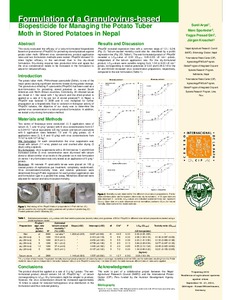Formulation of a granulovirus-based biopesticide for managing the potato tuber moth in stored potatoes in Nepal.
Abstract
The potato tuber moth, Phthorimaea operculella (Zeller) is one of the major insect pests causing significant economic losses during potato storage. The granulovirus infecting P. operculella (PhopGV) has been used as a dust-formulation for protecting stored potatoes in several South American and North African countries. In 2008, a PhopGV was also isolated in Nepal and in vivo multiplied at NARC for further propagation as a biopesticide. In this study, two formulation methods for a virus-talcum product (dry and wet), product’s virus titer, and application rate was tested in laboratory bioassays. For the wet formulation the virus was mixed with water and talcum (1:1 w/w) and the dried product was used; while for the second formulation a virus-talcum mixture was prepared similarly but with a 20-fold and 60-fold increased virus titer and then further mixed with talcum alone until obtaining the same virus titers as in the wet formulation. For each formulation and application rate, six virus concentration levels (from 0.007 to 6.8×10-6 larval equivalents (LE) kg-1 potato) were tested. Application rates of the product were variable between 3 and 12 g kg-1 potato. Bioassays were conducted with 50 neonate P. operculella larvae inoculated onto 100 g of treated potato tubers. Each treatment was replicated 4-times (completely randomised). Probit regression lines were fitted in a parallel assay to each formulation and application rate and treatments compared by the relative potencies. All regression lines revealed a common slope of 1.3 (SE±0.24). Talcum increased larval mortality through physical protection described by a probit line (y=-1.56+1.15 ln[x in g kg-1]). For the wet-formulated product data revealed a LC50-value of 0.30 (CL95%: 0.25-0.35) LE ton-1 potatoes, independent of the product’s application rate. For the dry-formulated product, LC50-value were variable ranging from 1.34 to 6.55 LE ton-1 potatoes, corresponding to potencies of 0.22 and 0.04-0.14 compared to the wet formulation, for the 20-fold and 60-fold increased virus stock preparation. It can be recommended to apply the product at a rate of 5 g kg-1; the product should contain 3.6 LE kg-1 talcum (LC99). The dry formulation method might be simpler to produce; however, the virus titer should be increased to adjust for reduced potency

